The Vulcain Cricket Nautical, The Return of The Alarm Dive Watch (Live Pics)
A cool take on an emblematic diving instrument first introduced over 60 years ago.
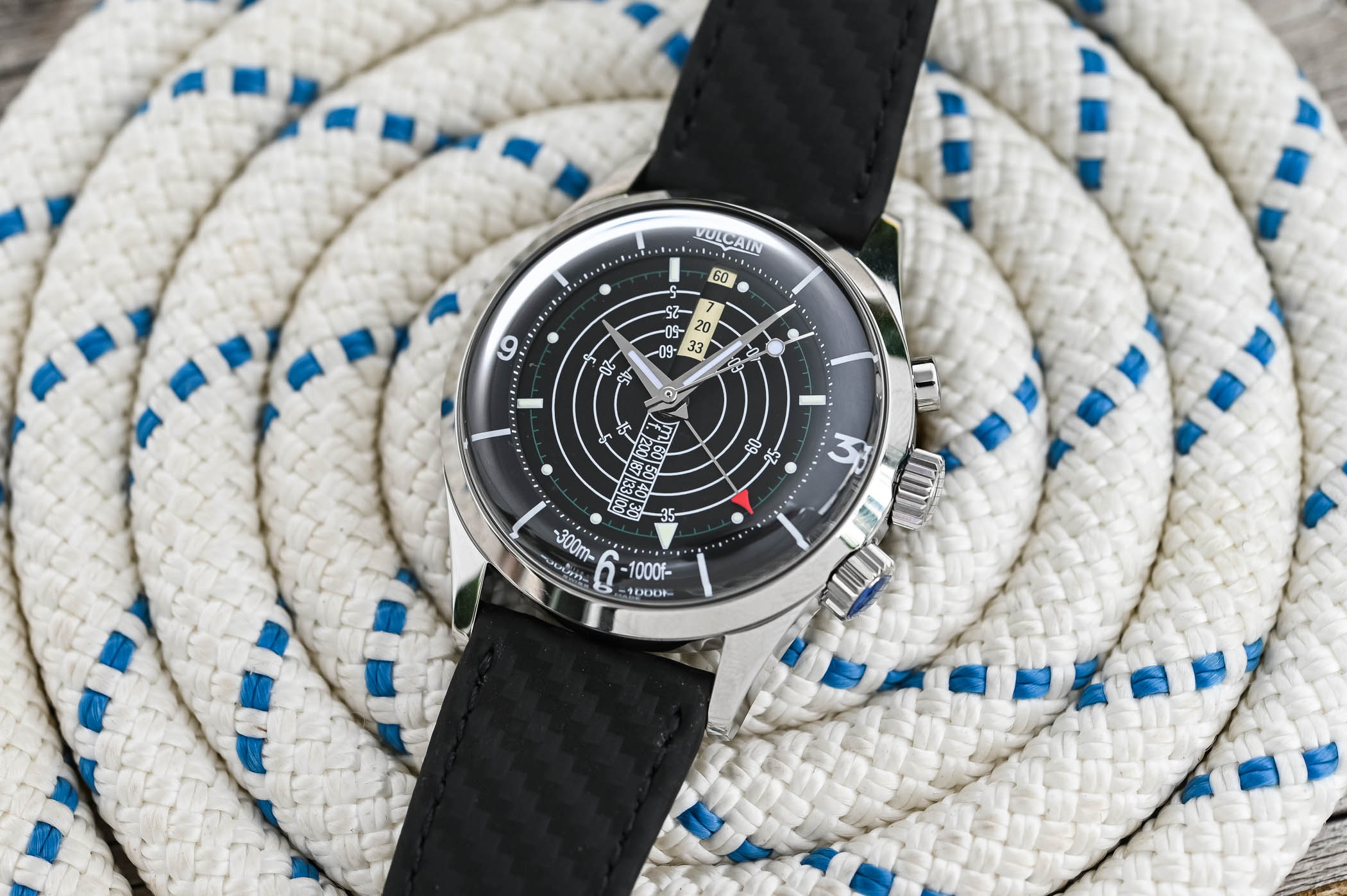
The name Vulcain is, for obvious reasons, often associated with the alarm complication. The venerable brand, founded in 1858 in Le Locle, Switzerland, has since 1947 made this function a signature element of so many of its watches. Slightly dormant in past years, the brand has recently been revived and various historical models have been brought back, with original movements and appealing retro-styled designs. In addition to the Skindiver Nautique, a classic dive watch, and an elegant chronograph, it’s mostly the return of the Cricket watch that caught our attention. Now, it’s time for one of the brand’s most important watches to return, a diving instrument with an underwater-ready alarm function, the Vulcain Cricket Nautical.
historical references
It took almost 100 years for Vulcain to properly make a name for itself. But in 1947, the brand and its manufacture will create a watch/movement that will define almost entirely its future production, the Cricket watch. To put it simply, it was the first alarm wristwatch to truly be worthy of the name. Surely, the concept for the wristwatch alarm was ‘patented in 1908 and put into production in 1910 by Eterna’ according to Ryan Schmidt in The Wristwatch Handbook. However, the two brands which really put the alarm wristwatch on the map were Vulcain, with its Cricket, and Jaeger-LeCoultre, with its Memovox. And unlike the Eterna with its one mainspring for the timekeeping functions and alarm, Jaeger-LeCoultre (as of 1950) and Vulcain (as of 1947) rely on two separate mainsprings.
With the development of professional and recreational diving, the alarm, as of the late 1950s, will take an entirely new function. Contrary to popular belief, sound travels well underwater and the alarm movement would become a rather practical safety feature for divers who wanted not only to track their diving times (that’s where a rotating bezel is used) but also add a function that could signal when it was time to head back up. The first attempt of a dive watch with an alarm has to be credited to Jaeger-LeCoultre with its Memovox Deep Sea in 1959, followed later by the Memovox Polaris in 1968.
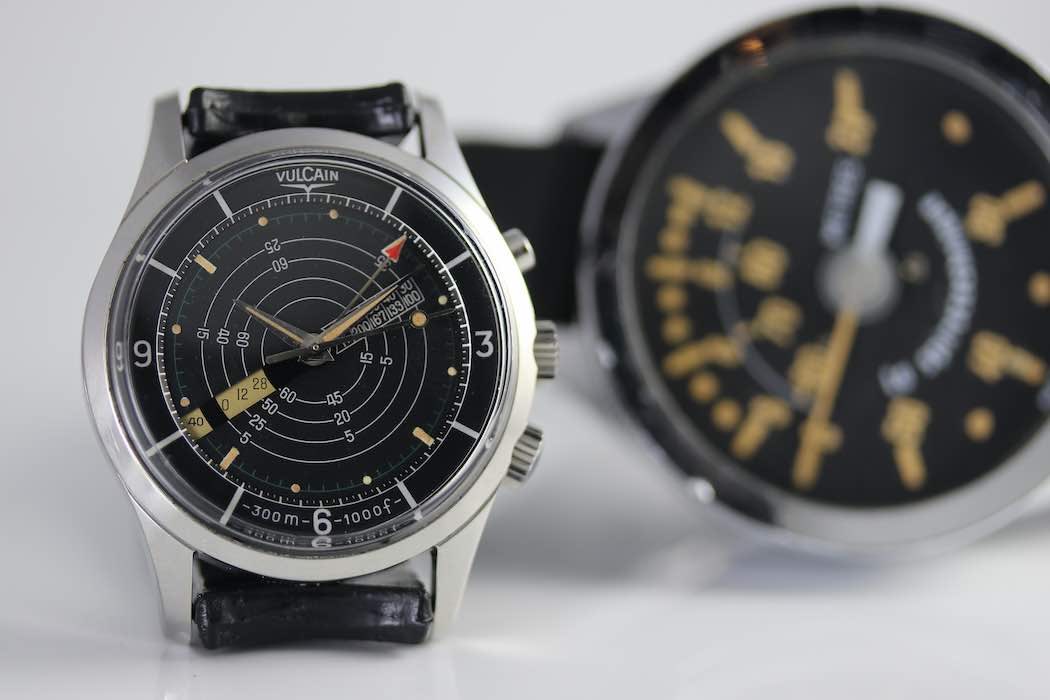
With this in mind, Vulcain, also a specialist in alarm watches, couldn’t let JLC be alone in this market. In the late 1950s, Vulcain decided to create a watch equipped with an alarm that could also be heard underwater, and thus adding an extra layer of safety to divers to know exactly when it was time to come back to the surface, not only thanks to a visual notice (the bezel and minute hand) but also through a loud and clear acoustic signal. The result was the 1961 Vulcain Cricket Nautical, equipped with a “triple case back” that acted as a resonance chamber, to amplify the sound underwater while still guaranteeing water-resistance.
But there’s much more to the Cricket Nautical than just its acoustic feature. In fact, it was the fruit of research conducted by 3 experts who pooled their knowledge and experience and, together with Vulcain, developed the very first dive watch that would not only feature a system for determining decompression times built right into the dial but also sound an alarm to signal the end of a diving session. Housed in a large 42mm case, with a solid 300m water-resistance, it was a distinctive watch with 2 crowns (movement, dial) and 1 pusher (alarm).
Behind the Cricket Nautical is a trio of passionate divers: Hannes Keller, a talented Swiss physicist/mathematician, occasional pianist, and deep-sea diving pioneer; Max-Yves Brandily, explorer and filmmaker; and Arthur Droz, a national certified diving instructor and representative of the C.I.A.S. And on November 3, 1966, in Toulon, France, Hannes Keller (who passed away recently) reached the abyssal depth of almost 250 meters with a Cricket Nautical on his wrist. The record was witnessed and validated by none other than Jacques Cousteau.
This very watch will remain one of the most fascinating and technically-advanced dive watches of its times. In 2011, to celebrate its 50th anniversary, it was re-created by Vulcain in a limited run of 1,961 watches. And yet again, the Vulcain Cricket Nautical is back in 2023.
The new Vulcain Cricket Nautical
Visually identical to the past, clearly intended for a niche audience, undoubtedly cool and ultra-focused, the Cricket Nautical comes back this year and takes advantage of modern technological advances to improve robustness and reliability.
Vulcain, now with the same man who has relaunched Nivada as a consultant, has been revived with a pretty simple yet efficient strategy; bringing back some of the most popular vintage watches to life. What sets Vulcain apart are the movements. Many brands simply rely on past designs and encase a modern movement inside a retro-looking (often enlarged) case. With Vulcain, on some of the references, you’ll get both the looks and the mechanics, as the classic cricket/alarm manufacture movement is still in production. And the new Cricket Nautical is no exception to the rule.
This re-edition of the Cricket Nautical is pretty straightforward and thus appealing. The ancient model stood out with ample dimensions for its time, at 42mm in diameter. And the new one sticks to these proportions – at least, Vulcain can’t be blamed for making an enlarged watch – with a polished steel case that measures 42.2mm in diameter… and over 17mm in height. Again, this was the case already for the vintage model and the combination of an alarm movement, a resonance chamber on the back, an ultra-domed sapphire and a multi-layer dial leaves no room for thinness. The Cricket Nautical was a large watch in the 1960s, and it is no different today. I guess it has to be accepted.
If the overall shape of the original model has been respected, it is the first time this model is fitted with a sapphire crystal, yet in a shape that respects the original charisma of the vintage watch. Being ultra-domed, it creates reflections and distortions – again not ideal regarding usability but charming. The classic features of the original model, meaning the two crowns and a pusher on the right side, as well as the complex caseback are retained. The latter acts as a resonance chamber, allowing the alarm function to be used underwater, amplifying the vibration of the cricket function. Just like the vintage model, this re-edition is water-resistant to 300 metres.
The dial of this Cricket Nautical stays true to the design and functionalities of the past. First of all, it’ll be available in two versions. Both have a semi-matte base in black, but they can feature either faux-patina SLN with an emerald green minute track, or white SLN with a lagoon blue minute track. Time is classically displayed by 3 central hands, while the alarm function has its own red arrow-shaped hand. The alarm, in the context of a dive watch, has to be set prior to the dive, in order to let the diver know when it’s time to resurface.
Now we come to the central part of the dial… And it’s quite a complex one, in all fairness. The dial is composed of two elements; a fixed, champagne-toned lower plate with scales; an upper, black-toned rotating plate that is actuated by the crown at 4 o’clock and can be used for two separate functions. First of all, you’ll note an arrow and 5-minute markers. In this instance, the central dial can be used just like a rotating bezel – point the arrow next to the minute hand when you start diving and then track the duration of your underwater excursion.
But of course, it’s the decompression table that is the most important function. It features a Keller-Bühlmann table used to determine the decompression times and steps depending on the depth and duration of the dive. The opening in this dial allows you to determine the respective stop times required at the depths of 9, 6 and 3 meters when ascending back to the surface.
How to effectively use the Vulcain Cricket Nautical in real life, to its full potential (yes, it’s complex…)? It’s a multiple-step process. First, you need to determine in advance the depth and duration of your dive (something that most pro divers will do before diving). Then, here are the steps – for the record, imagine you’re diving at a depth of 30 metres, for 45 minutes, starting at 09:10.
- Step 1: Set the alarm for 45 minutes. You’ll thus be positioning the red arrow hand at 09:55
- Step 2: Rotate the dial so the printed arrow (in white, next to the table, marking the zero) is under the minute hand
- Step 3: Determine the necessary decompression time using the white printed scales on the dial and the table. In the present case, use the circle corresponding to a 30m depth (the one on the edge of the dial) and read the decompression time corresponding to a 45-minute dive, by using the position of the alarm hand. In this case, the alarm hand is positioned right between the 15 and 25 mark, indicating a 20-minute decompression time
- Step 4: Rotate the dial again so the champagne-toned disc is positioned at the 20-minute mark. The aperture next to it will indicate 3 numerals – 0, 4 and 16 – corresponding to a 0-minute step at 9 metres, a 4-minute step at 6 metres and a 16-minute step at 3 metres.
In the two images above, the decompression scale works this way. For a 40-minute decompression, you’ll need a 0-minute stop at 9 metres (so you simply don’t stop), a 12-minute stop at 6 metres and a 28-minute stop at 3 metres. For a 55-minute decompression, you’ll need a 4-minute stop at 9 metres, a 18-minute stop at 6 metres and a 33-minute stop at 3 metres.
Overall, it’s a complex function, and this rotating dial refers to diving protocols determined decades ago, which are not necessarily the standards of today. We can call this dial obsolete in a time of diving computers. However, it certainly has great charm and charisma.
Under the sophisticated caseback is the same movement as the classic Vulcain Cricket, the hand-wound calibre V-10. This movement, an evolution of the calibre unveiled in 1947, is exclusive to the brand. It has a twin-barrel architecture (one for timekeeping, one for the alarm) and the classic buzzing hammer system for the alarm. It also retains the Exactomatic, a patented device to equalise the friction on the balance-wheel axis in all positions by modifying the Incabloc endstones. Running at a slow pace of 2.5Hz, it can store up to 42 hours of energy when fully wound.
Availability
Worn on a black leather strap with water-resistant carbon texture, the Vulcain Cricket Nautical will be available as of September 21st, 2023. The watch will be available from CHF 4,200. More details soon at vulcain.ch.

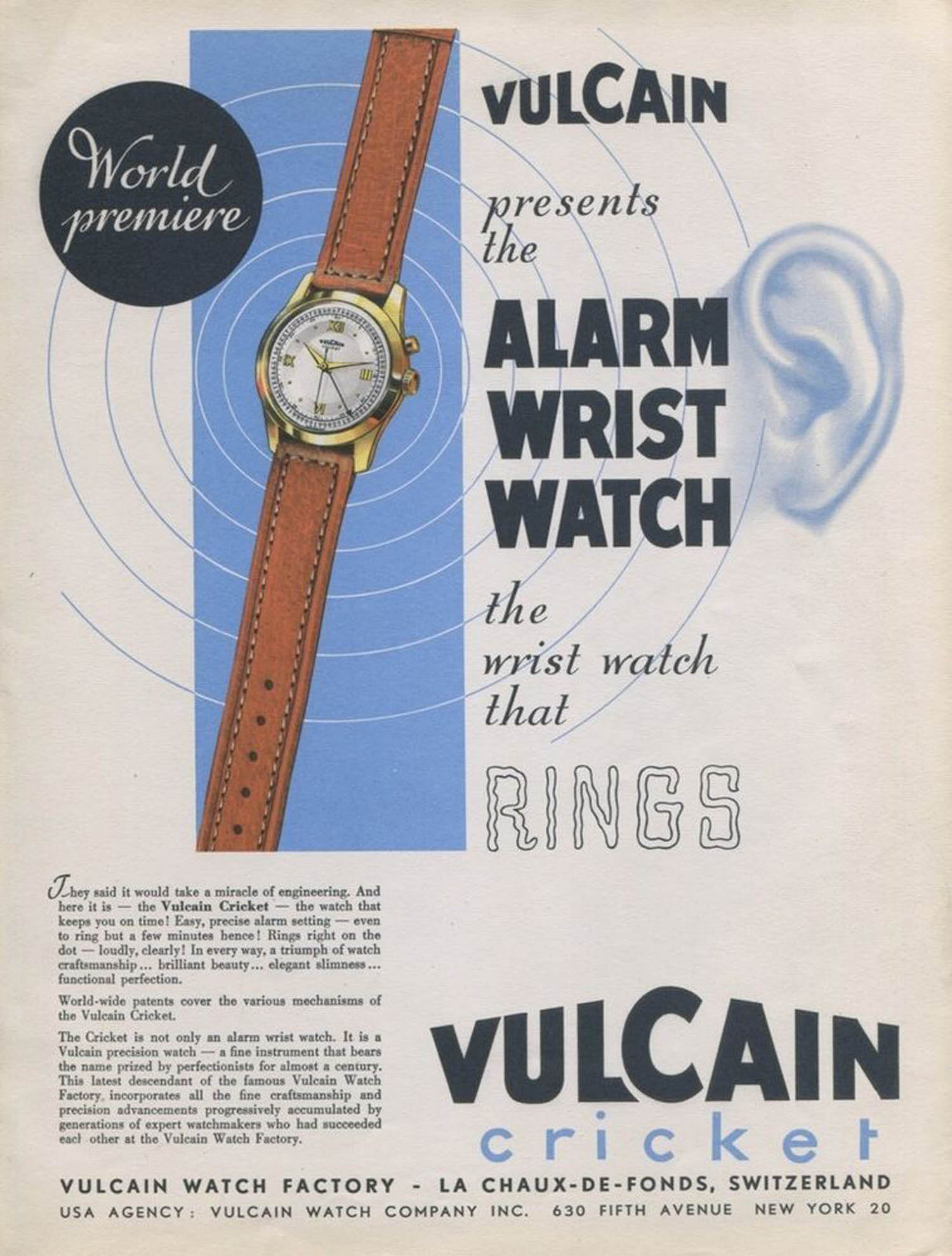
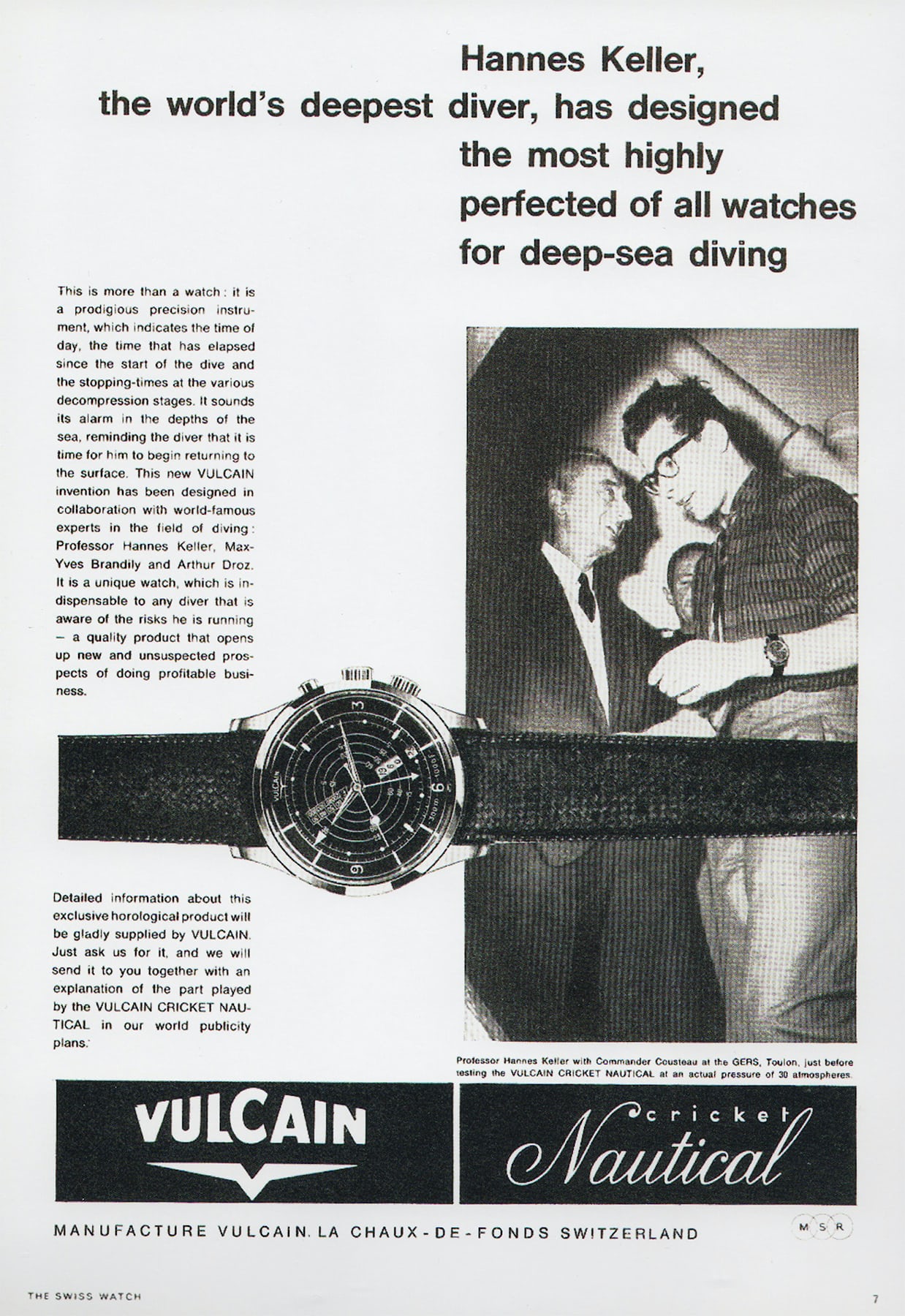

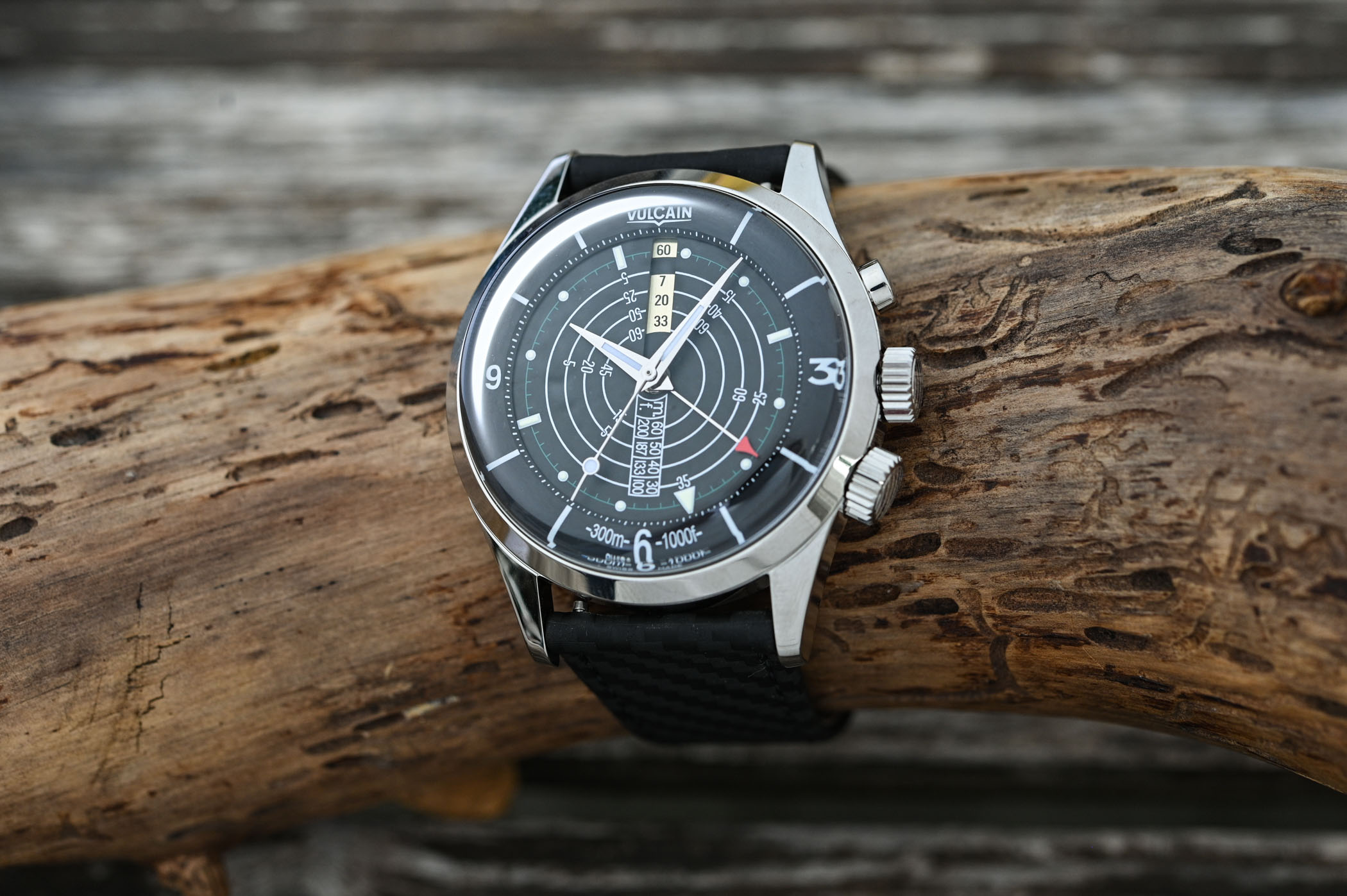
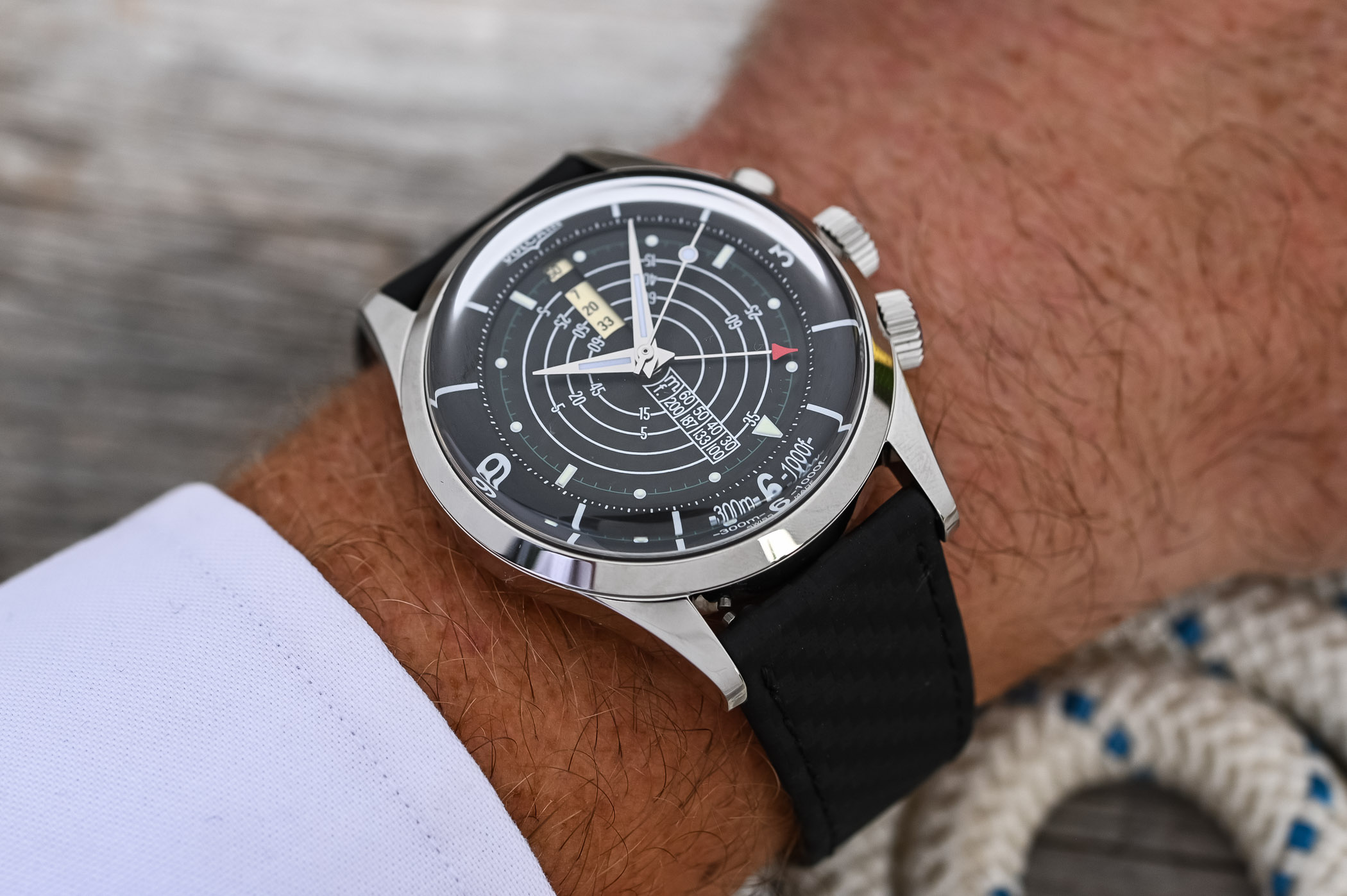
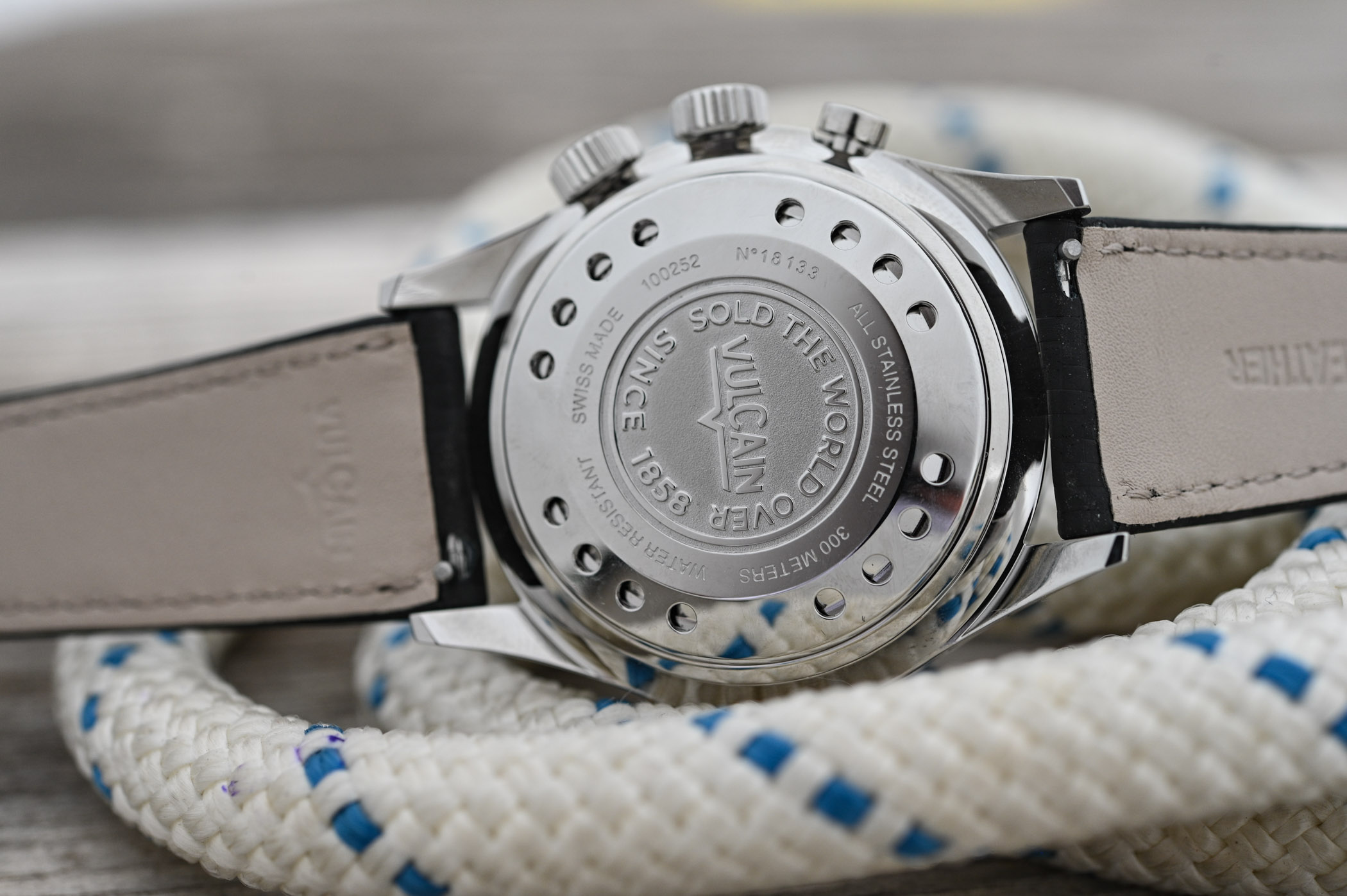
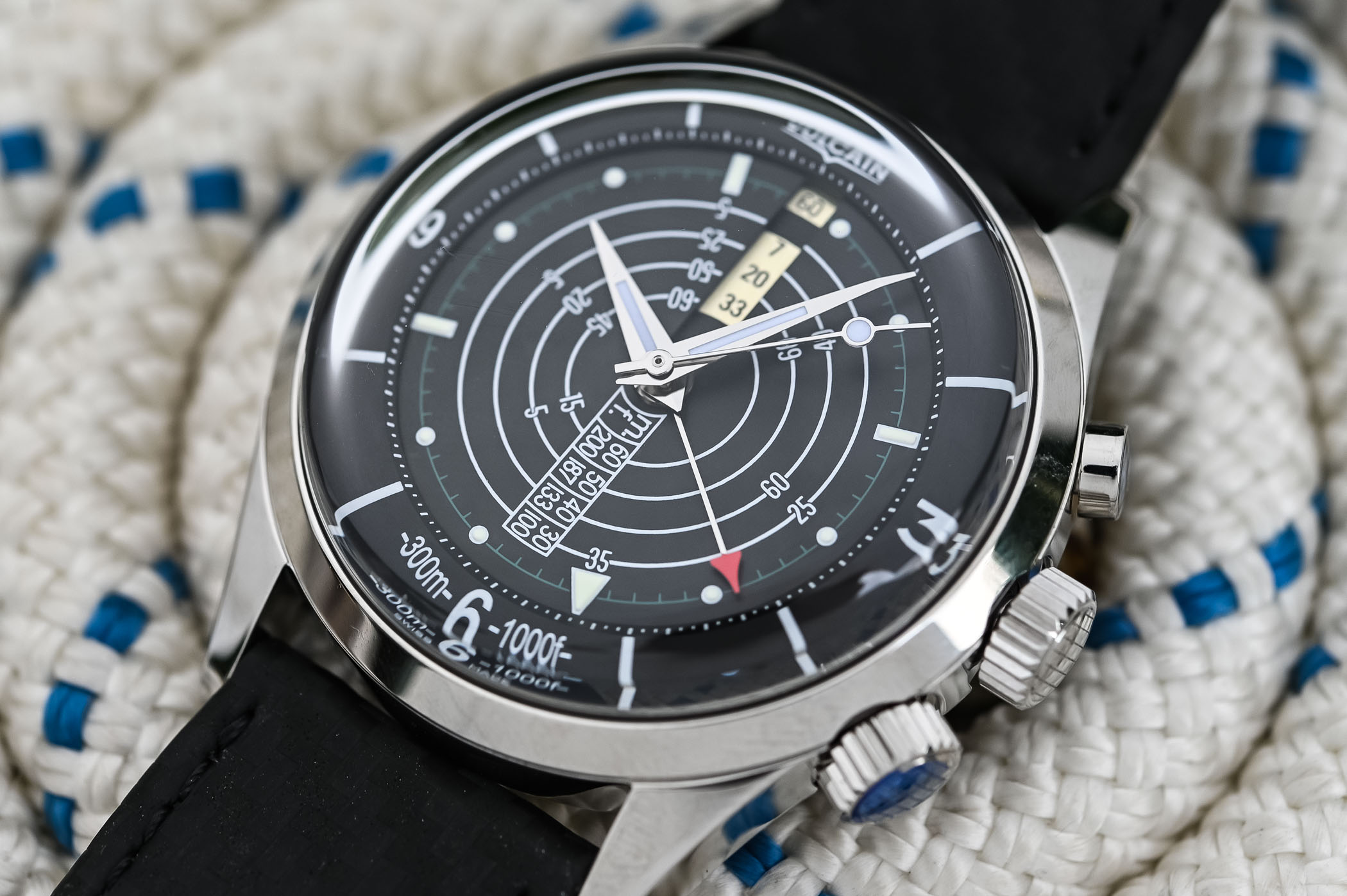
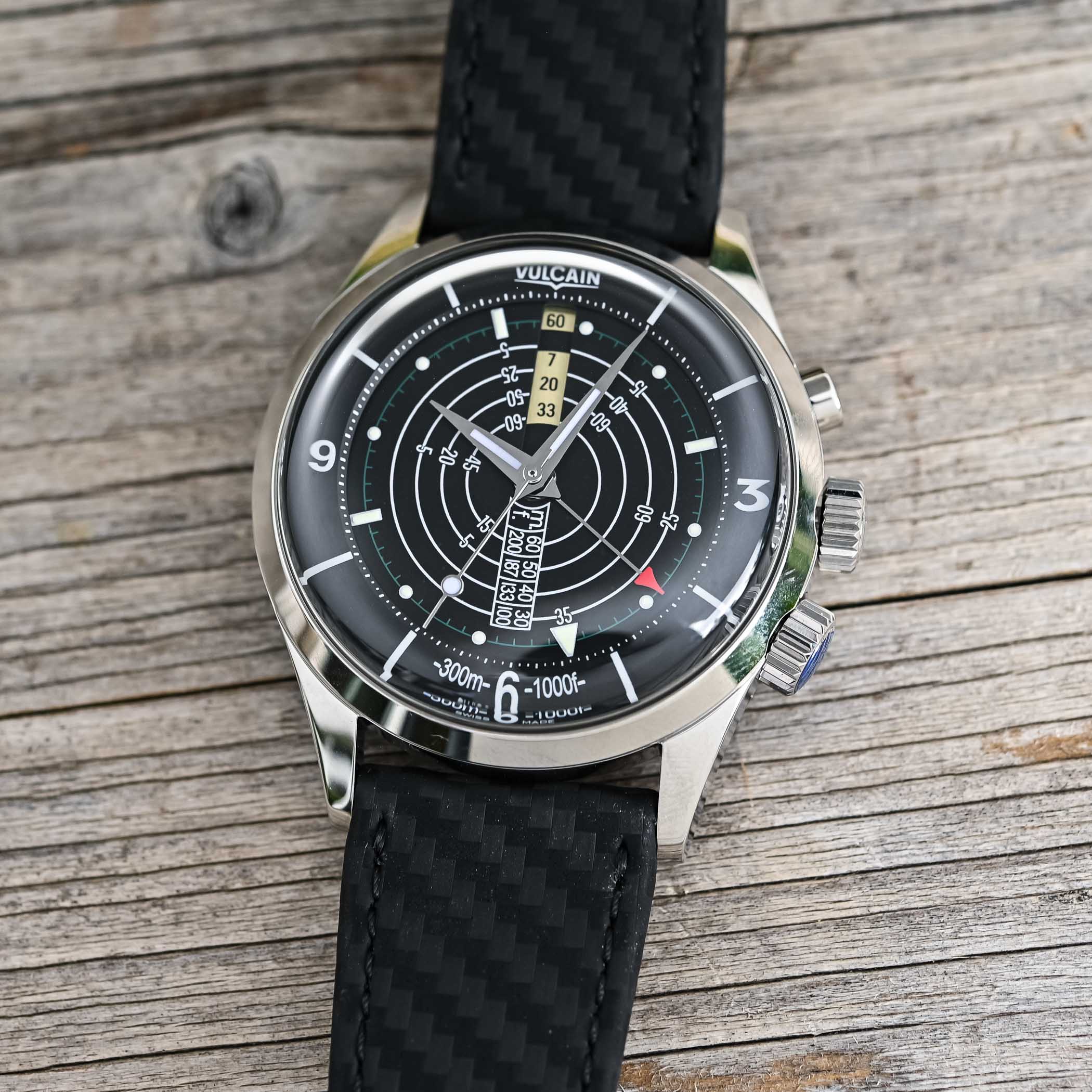


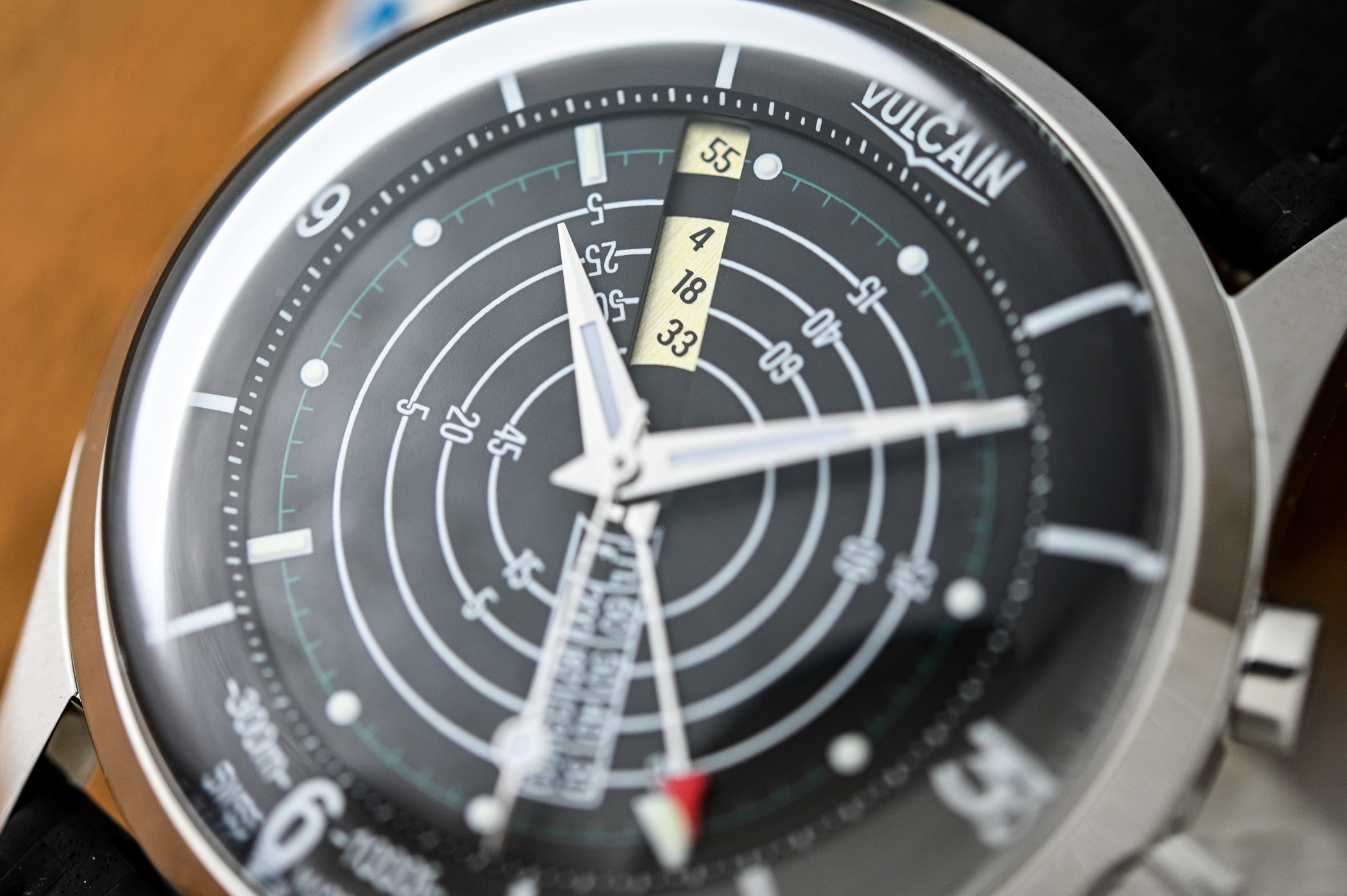






3 responses
I think the case and lugs def look better on this one than the last reissue. Looking forward to the price hope it’s not too aspirational.
Nice to see that Vulcain is back with its Nautical. I own one from early 2000 and I am very happy with the look, sound and time precision; quite less with readability (especially at night, given the poor amount of luminova). Also the exact timing of the alarm is a bit tricky in terms of precision to the minute. Hope these small issues have been addressed in this new edition.
Regards, slide68
cannot b reliable with the alarm . not to the minute. at best, i say to the 15mn. not sure how diver were using the alarm back in the days